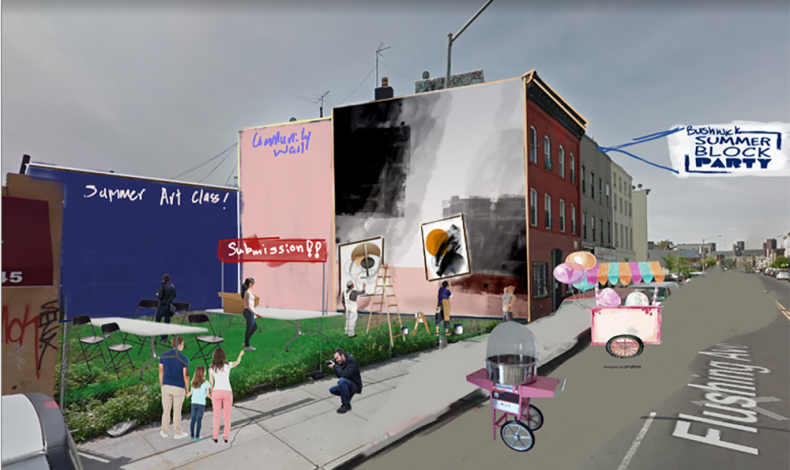When Summer Camp Looked Unlikely, Weitzman Launched First-of-Its-Kind Virtual Design Studio

The Weitzman School partnered with the non-profit organization The Fresh Air Fund to launch a first-of-its-kind virtual studio.
As a large number of summer activities moved online due to COVID-19, the Weitzman School partnered with the non-profit organization The Fresh Air Fund to launch a first-of-its-kind virtual studio. Led by PennPraxis Design Fellows, Fresh Air Everywhere was an intensive seven-week program that provided high school students with an introduction to the fields of design and architecture while fostering skills in communication and community engagement.
“A spirit of giving back”
The goal of the virtual studio was to provide both an enriching summer experience for high schoolers who had lost out on summer activities and to support Weitzman Design Dellows who had lost out on summer internships. “We’ve always had a spirit of giving back, and we knew that it was going to be a difficult summer,” says Lori Kanter Tritsch, a Penn alumna and member of the Board of Overseers for the Weitzman School, who helped connect Penn Praxis Executive Director Ellen Neises [who is also an adjunct associate professor of landscape architecture at Weitzman] with The Fresh Air Fund.
Earlier this summer, The Fresh Air Fund, whose goal is to provide New York City children from low-income communities with opportunities to connect to the outdoors, was in the process of re-imagining their typical summer programming, and connecting with Penn provided a unique opportunity to empower students through design-based thinking. “Connecting kids to the outdoors is one reality, but we also provide opportunities to explore and meet new people,” says Fresh Air Fund Executive Director Fatima Shama. Another goal of the program, adds Shama, was to provide stipends for New York City high school students who rely on the Summer Youth Employment Program, which was cancelled this summer.
Neises brought together a team of students and recent graduates from the architecture, fine arts and landscape architecture departments, who took on the enormous task of developing a curriculum, and preparing and shipping packages of drawing materials to the homes of 150 high schoolers, all in a matter of weeks. Then, during the seven-week program, students met online in small groups from 10 am to 2 pm every weekday, participating in a mix of online and offline activities with virtual lessons led by a Design Fellow instructor, a Fresh Air mentor, and a recent Weitzman graduate.
Along with attending guest lectures and collaborating and critiquing the work of their peers, the program also helped connect students with resources and mentors from the fields of design and architecture. The Point Community Development Corporation in the Bronx, The Beam Center in Brooklyn, and the Black Rock Forest Consortium in Cornwall, New York helped students think about the context for their design work, provided comments on work in progress, and connected the young people to resources in New York to help them continue to explore career paths. Many faculty supported the Design Fellows by participating in reviews of the student work.
Creative, honest, and responsive designs
Each “camper” completed two design projects, the design of the nature center at The Fresh Air Fund’s Sharpe Reservation and a “breathing room” for the student’s own borough, a space that could be broadly interpreted from a place for social activity or exercise, a way to improve air quality, or installations that stimulate conversations on racism and the Black Lives Matter movement which campers presented virtually during the last week of the program. Proposed redesigns for the Sharpe Nature Center included a tree library, an adventure course, and a multi-story treehouse, while many breathing room projects combined green, natural areas with space to create art and connect with others in the community.
Natalia Revelo La Rotta, a third-year Master of Architecture student and a co-founder of Inclusion in Design, saw the summer studio not only as a fantastic opportunity to work with students who were new to design but also as a way to incorporate more diversity into a design studio. Working with fellow program coordinators David Johnson and Xan Lillehei, Revelo La Rotta helped put together a curriculum that incorporated non-European perspectives and guest speakers of color. “A lot of the people we brought in to speak were people that would look like the students, and the references in the projects that we used to encourage their design thinking, were also highlighting works of people of color across disciplines,” says Revelo La Rotta.
Second year Master of Architecture student and Design Fellow Reem Abi Samra says that one of the most challenging yet invigorating experiences as an instructor was emphasizing how and when students were engaging with the design process, such as when they talked about issues of space in their community and postulating a solution, however simple. “What you are doing right now is designing, by just thinking of the problem and finding a solution,” Abi Samra would tell her students. “Defining what design and architecture means, and teaching that thinking, was the most challenging and most fun experience.”
Read the full story on the PennToday website.

